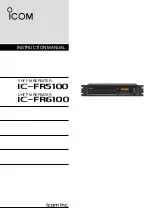
Compact Unit Heater
5
Operating Instructions and Owner’s Manual
RECEIVING INSTRUCTIONS
1. Before signing the bill of lading:
a. Confirm that the information on the bill of lading matches
what was received, including quantity of heaters.
b. Remove all packing material and inspect the heater for
damage.
2. If there is damage or discrepancy on the bill of lading, the
consignee should sign the bill of lading listing all damages or
discrepancies.
3. Take pictures of damage with the delivery person present.
4. If there is no damage, sign the bill of lading.
5. Confirm that the model number of the heater matches the model
number that you ordered.
HEATER INSTALLATION
1. Read the entire installation and service manual before starting the
installation.
2. Keep the installation and service manual and other literature for
future reference.
3. The installation must comply with the latest edition of:
a. All local codes, including building, plumbing, electrical and
wastewater codes;
b. In the absence of local building codes refer to:
•
In the USA- The National Fuel Gas Code, NFPA
54/ANSI Z223.1
•
In Canada- The Natural Gas and Propane Installation
Code, CSA B149.1
c. National codes, such as OSHA in the USA.
d. In this manual the above applicable codes are referred to as
“local/national codes”
4. Installation and service must be performed by a qualified
installation and service agency as defined in NFPA 54, or in
Canada by a licensed gas fitter.
5. Do not attach to duct work or air filters. Do not place
downstream from cooling/refrigeration units, air washers or
evaporative coolers.
6. This unit is certified with the controls furnished. For replacement
parts, please order according to the replacement parts list. The
manufacturer reserves the right to substitute other authorized
controls as replacements.
7. Do not adjust or alter the fan blade or motor operating speed.
8. The heater must be installed to maintain normal room
temperatures. Operating temperatures below 50°F (10°C)
can result in premature failure of the heater and cause unsafe
operation. Thermostats with a minimum operating temperature
of 50°F (10°C) should be installed.
9.
The heater cannot be operated in temperatures above 90°F
(32°C). Operating the heater above 90°F (32°C) can cause failure
of the heater and electrical components and result in unsafe
operation.
10. Do not install the heater outdoors. Avoid water spray and
dripping of water onto the heater.
11. High humidity and high salt areas can damage the heater and
reduce the life of the heater resulting in unsafe operation.
12. Verify that the heater can be safely vented to the outdoors
according to these instructions and local/national codes.
13. Do not install units in locations where the flue products can be
drawn into adjacent building openings such as windows, fresh air
intakes and doors.
14. Maintain the minimum clearances/distance to combustible
materials and recommended service clearances shown in Figure 2
and Table 3.
15. All appliances and machines generate noise. This heater
generates noise and vibration from the fan, motors and
combustion processes. This noise could be considered a nuisance
near quiet zones such as offices.
16.
Utility heaters must be installed at least 18” (46 cm) above the
floor in garages.
17. The heater should be installed so that air can move freely to all
air openings on the heater. This includes combustion air and air
for the fan.
TABLE 3
Distance to Combustible Surfaces, Materials
and Access
Unit Side
HSU100-125 HSU150-400
Service Clearance
(Suggested)
Top and Bottom
1 in.
2.54 cm
6 in.
15.24 cm
18 in.
45.72 cm
Access Side
1 in.
2.54 cm
6 in.
15.24 cm
18 in.
45.72 cm
Non-Access Side
1 in.
2.54 cm
1 in.
2.54 cm
18 in.
45.72 cm
Rear
18 in.
45.72 cm
18 in.
45.72 cm
18 in.
45.72 cm
•
For propane installations the conversion label was filled out and attached to the heater near the name plate?
•
For installations above 2,000’ (610m) the high altitude label was filled out and attached to heater near the name plate?
•
All wires are tight and all gaskets intact and all plugs/caps in place?
•
The air louvers are open and the access panel has been replaced?






































